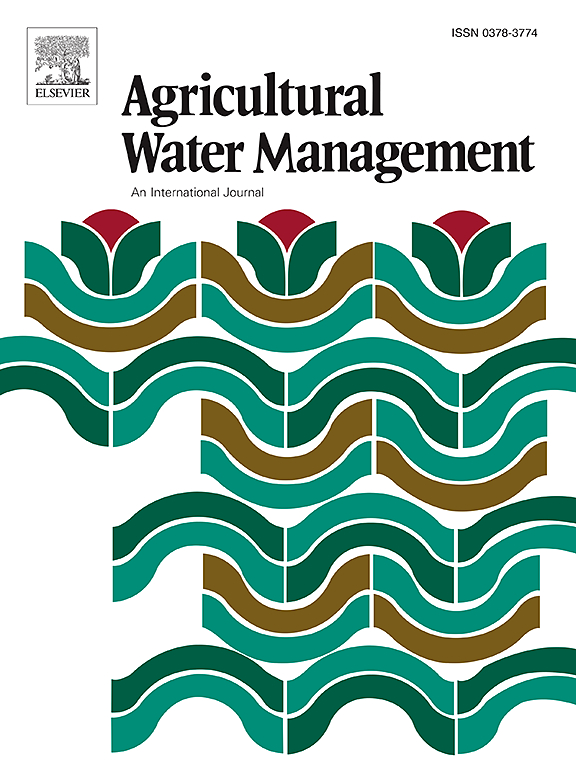在雨水灌溉条件下进行的玉米田间试验中,秸秆还田重新排列了土壤孔隙结构,改善了土壤水分记忆能力
IF 5.9
1区 农林科学
Q1 AGRONOMY
引用次数: 0
摘要
秸秆还田通常用于提高土壤肥力和质量,从而提高作物产量;然而,不同的秸秆管理方式对土壤水分变化、土壤水分对降水的响应以及土壤孔隙性质的影响仍然很不充分,更不用说这些因素之间的关系了。为了填补这一知识空白,我们在中国东北地区开展了一项固定地点秸秆还田试验,包括秸秆清除(CK)、秸秆直接还田(SD)和秸秆生物炭还田(BC),监测了2022年至2023年玉米生长季期间土壤水分的时间动态变化。与秸秆还田相比,秸秆生物炭还田对土壤水分有显著影响,2022 年 9 月的月平均墒情增加了 30.3%,年平均墒情增加了 5.90%(P <0.05)。此外,SD 使 6 月份的月平均降雨量明显增加了 28.5 %(P < 0.05),土壤水分与降雨量之间的线性相关关系更加明显,斜率最大(y = 0.2061x + 0.0026,R² = 0.3098)。结果表明,秸秆还田提高了土壤的蓄水能力,在 2022 年对 BC 产生了更有效的影响,但在 2023 年对 SD 产生了更有效的影响,部分原因是这两年的降水量、降水强度和降水频率存在差异。此外,根据对土壤保水能力的评估,BC 在 2022 年(P < 0.05)和 2023 年(P < 0.01)都明显减少了降水耗散部分,增强了土壤水分记忆。X 射线计算机断层扫描(CT)结果表明,秸秆还田重建了相对复杂的孔隙网络,其特点是:SD 的孔隙度和大孔数量增加,孔隙圆度增加,BC 的孔隙直径和大孔数量减少,这与土层深度有关。结论是,在秸秆还田条件下,土壤水分和孔隙性质的改善(表现为土壤水分记忆增强和孔隙度增加)有助于提高土壤养分。这项研究为选择合适的秸秆还田模式提供了宝贵的启示,从而促进农业系统,特别是干旱地区秸秆和水资源的有效利用。本文章由计算机程序翻译,如有差异,请以英文原文为准。
Straw return rearranges soil pore structure improving soil moisture memory in a maize field experiment under rainfed conditions
Straw return is commonly used to improve soil fertility and quality, thereby contributing to improved crop production; however, the influence of different straw management on soil moisture variation, its response to precipitation, and soil pore properties remains largely inadequate, let alone the relationships between these factors. To fill this knowledge gap, the temporal dynamics of soil moisture were monitored during the maize growing season from 2022 to 2023 in a fixed-site field experiment on straw return, including straw removal (CK), straw direct incorporation (SD) and straw-derived biochar incorporation (BC), in Northeast China. In contrast to CK, BC was observed to have a significant impact on soil moisture, increasing the monthly average of September by 30.3 % and the annual average by 5.90 % in 2022 (P < 0.05). In addition, SD significantly increased the average for June by 28.5 % (P < 0.05) and exhibited a more pronounced linear correlation between soil moisture and rainfall amount with the greatest slope (y = 0.2061x + 0.0026, R² = 0.3098). The results indicated that the soil water storage capacity was enhanced when straw was returned, with a more effective impact in BC in 2022 but in SD in 2023, partially attributing to the discrepancies in precipitation quantity, intensity, and frequency between the two years. Furthermore, BC significantly reduced the dissipated precipitation fraction and enhanced the soil water memory in both 2022 (P < 0.05) and 2023 (P < 0.01), based on the evaluation of the capacity of soil to retain water. The results of X-ray computed tomography (CT) scanning showed that straw return resulted in the reconstruction of a relatively intricate pore network, which was characterized by an increase in porosity and macropore number in SD, an increase in pore circularity, a reduction in pore diameter and maccropore number in BC, which was associated with soil layer depth. It is concluded that the improvement of soil water and pore properties, as evidenced by an enhanced soil moisture memory and an increased porosity, contributed to the enhancement of soil nutrients under straw return conditions. This study provides valuable insights for selecting a suitable mode of straw return, thereby facilitating the effective utilization of straw and water resources in agricultural systems, particularly in arid regions.
求助全文
通过发布文献求助,成功后即可免费获取论文全文。
去求助
来源期刊

Agricultural Water Management
农林科学-农艺学
CiteScore
12.10
自引率
14.90%
发文量
648
审稿时长
4.9 months
期刊介绍:
Agricultural Water Management publishes papers of international significance relating to the science, economics, and policy of agricultural water management. In all cases, manuscripts must address implications and provide insight regarding agricultural water management.
 求助内容:
求助内容: 应助结果提醒方式:
应助结果提醒方式:


